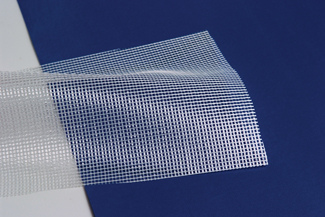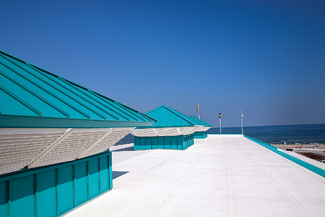By Janet Bealer Rodie, Contributing Editor
Hurricanes, tornadoes and other high-wind weather events can destroy or seriously damage roofs on homes and businesses. To help provide tear resistance and improve performance during such events, commercial roofing membranes typically contain a textile reinforcement.
Spartanburg-based Milliken & Company has developed and manufactured textile reinforcements for roofing for more than 40 years, according to Jeff Stafford, global sales and marketing leader for Milliken’s Advanced Reinforcements business unit. To reduce the potential impacts of high wind loads on commercial roofs, Milliken recently launched a cost-effective, weft-inserted warp-knit, coated textile reinforcement that can replace traditional scrims in commercial roofing manufactured using conventional processes. The company claims this scrim doubles tear resistance in most single-ply roofing membranes and enables improved ply-to-ply adhesion.

Milliken’s newest roofing reinforcement features a proprietary coating to add strength and a more open construction to enable improved ply-to-ply adhesion in membranes such as PVC membranes.

Application photograph courtesy of Carlisle Syntec Systems
The scrim, currently made using polyester and potentially using a range of specialty materials, features a proprietary coating that gives added strength to the fabric and contains no plasticizers or volatile organic compounds. The scrim can be incorporated into thermoplastic polyolefin- and polyvinyl chloride (PVC)-based single-ply membranes. The construction is 5- to 10-percent more open than traditional scrim constructions, thus allowing the improved ply-to-ply adhesion.
Stafford noted that commercial roofing membranes are attached to the roof using either mechanical fastening systems, or an adhesive or other compounds such as polyurethane. “In the case of mechanically fastened membranes, high-wind-load events create a vacuum as the wind passes over the roof and tries to lift the membrane off of the roof, so all the stress is distributed to these fasteners,” he explained. To improve wind resistance, “you can add a lot more fasteners, which adds a lot more labor and materials cost, or you can use a stronger textile reinforcement. But traditional textile scrims also affect the ply-to-ply adhesion of the membrane, and you might spend much more to get the performance no matter what you did, until now.”
With Milliken’s new scrim, Stafford noted, “There’s minimal additional cost for a vast performance improvement, and there are benefits downstream for our customers, who potentially can do much more than offset the cost by reducing the labor and materials content in building the roof. They could expand the distance between fasteners and take cost out of their construction, or they could keep the same construction methods and meet a much higher wind-load standard.”
Milliken manufactures its new reinforcement at its plant in Laurens, S.C., for the Americas market, and also at its facilities in France and Belgium for the European market. “In Europe, this innovation is even more timely,” Stafford said, noting that performance standards have been lower there than in the United States. “There, they use a lot of woven loom-bonded products, typically coated with PVC plastisol. More cost is involved with these traditional products, so our product allows a manufacturing cost decrease as well as a performance increase.”
For more information about Milliken’s newest warp-knit roofing membrane reinforcement, contact Jeff Stafford, +864-503-1708, jeff.stafford@milliken.com.
July/August 2015




